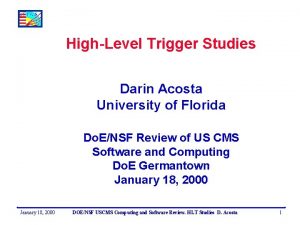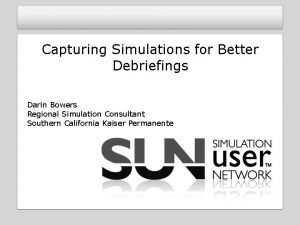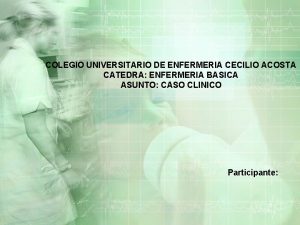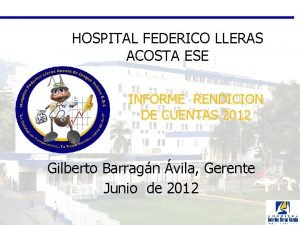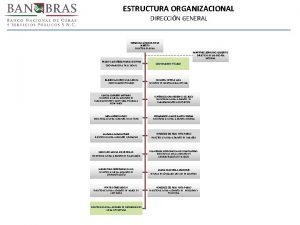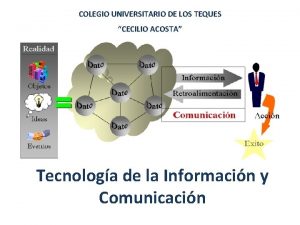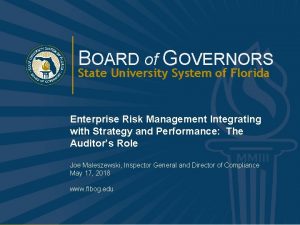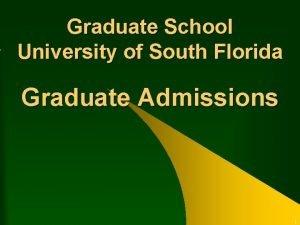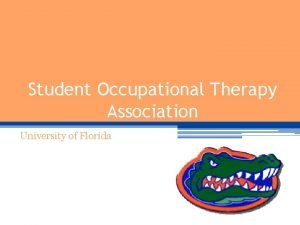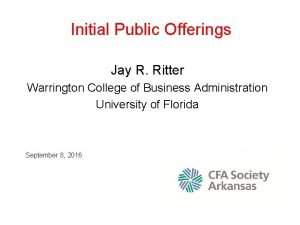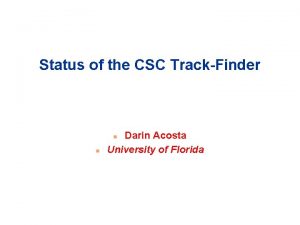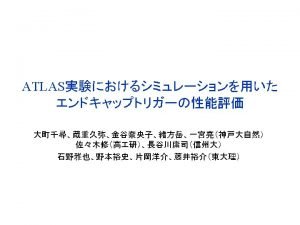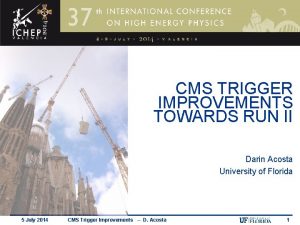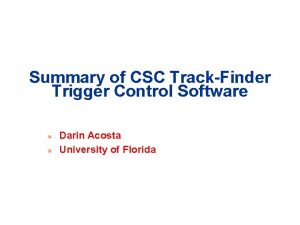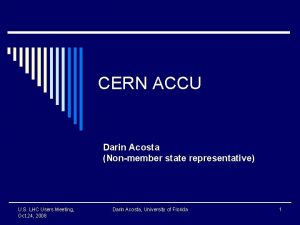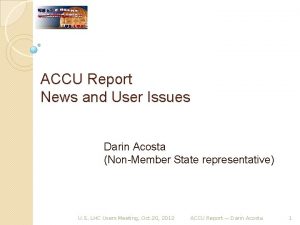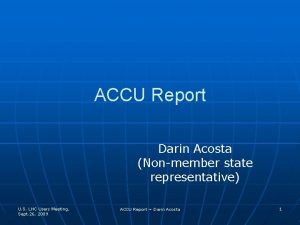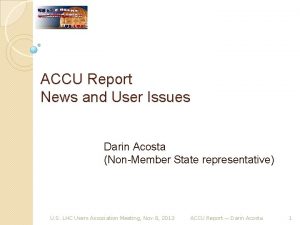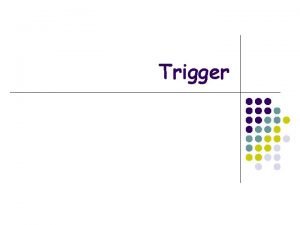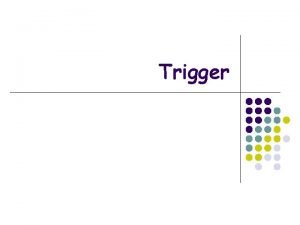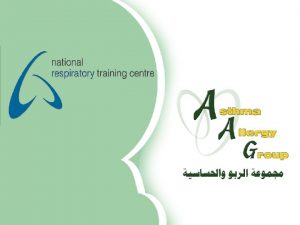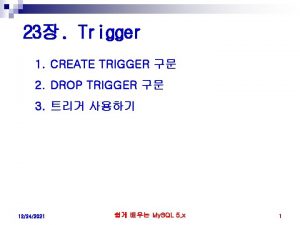Muon TrackFinder Trigger Darin Acosta University of Florida


















- Slides: 18

Muon Track-Finder Trigger Darin Acosta University of Florida June, 2002 US CMS DOE/NSF Review: June 2002, Darin Acosta, University of Florida 1

Muon Track-Finding • Link trigger primitives into 3 D tracks • Measure p. T, , and in non-uniform fringe field • Send highest quality candidates to Global L 1 • Partitioned into 60° sectors that align with DT chambers US CMS DOE/NSF Review: June 2002, Darin Acosta, University of Florida 2

CSC Muon Trigger Scheme EMU Trigger On-Chamber Trigger Primitives Trigger Motherboard (UCLA) Strip FE cards Muon Port Card (Rice) LCT 3 -D Track-Finding and Measurement Sector Receiver/ Processor (U. Florida) OPTICAL FE SR/SP MPC LCT 3 / port card TMB FE SP 2 / chamber Wire LCT card Wire FE cards RIM RPC Interface Module 3 / sector In counting house RPC Combination of all 3 Muon Systems US CMS DOE/NSF Review: June 2002, Darin Acosta, University of Florida 4 CSC Muon Sorter (Rice) DT 4 4 Global Trigger 4 Global L 1 3

Scope of CSC Track-Finder Baselined with 24 crates, reduced to 6 in 1998, now 1: Prototype version tested Fall 2000: Board # units Responsibility New version (SR/SP combined) MPC 48 Rice Sector Receiver 24 UCLA Board Sector Processor 12 Florida MPC 48 Rice SR/SP 12 Florida Clock and Control Board 6 Rice Clock and Control Board 1 Rice CSC Muon Sorter 1 Rice Crates, Backplanes 6 Florida Crates, Backplanes 1 Florida DDU readout 1 Florida/Ohio State US CMS DOE/NSF Review: June 2002, Darin Acosta, University of Florida # units Responsibility 4

Prototype Track Finder Tests Focus during FY 2000 was on producing and testing prototypes of all Track-Finder components (except the CSC Muon Sorter) • • • Sector Processor: UFlorida Sector Receiver: UCLA Muon Port Card: Rice Clock and Control Board: Rice Channel-Link backplane: UFlorida Integration tests of the complete system yielded 100% agreement between hardware and software for random and simulated physics events US CMS DOE/NSF Review: June 2002, Darin Acosta, University of Florida Sector Processor FIFO Custom Back plane FIFO Sector Receiver FIFO 100 m Optical Links FIFO Port Card FIFO DAQ System (VME, Bit 3 Controller, PC running Windows NT) Results included in Trigger TDR 5

Sector Receiver Prototype UCLA Optical Receivers and HP Glinks SRAM LUTs Receives and formats track segment data Front FPGAs US CMS DOE/NSF Review: June 2002, Darin Acosta, University of Florida Back FPGAs 6

Sector Processor Prototype Final Selection Unit Extrapolation Units XCV 150 BG 352 XCV 400 BG 560 Florida Links track segments into 3 D tracks, selects best three tracks, measures momentum 12 layers 10 K vias 17 FPGAs 12 SRAMs 25 buffers Assignment Units Track Assemblers Bunch Crossing 256 k x 16 SRAM XCV 50 BG 256 & Analyzer 2 M x 8 SRAM US CMS DOE/NSF Review: June 2002, Darin Acosta, University of Florida XCV 50 BG 256 7

1 st Track-Finder Crate Tests Sector Processor (Florida) Sector Receiver Clock Control (UCLA) Board (Rice) Bit 3 VME Interface Custom Channel. Link Backplane (Florida) Prototype crate for original six crate design US CMS DOE/NSF Review: June 2002, Darin Acosta, University of Florida Muon Port Card (Rice) Very successful, but overall CSC latency was too high -New design in 2001 improves latency 100 m optical fibers 8

New Track-Finder Crate Design Muon Sorter SR SR SR / / / SP SP SP MS CCB Clock and Control Board BIT 3 Controller Single Track-Finder Crate Design with 1. 6 Gbit/s optical links SR SR SR / / / SP SP SP From Trigger Timing & Control SR/SP Card (3 Sector Receivers + Sector Processor) (60° sector) From MPC (chamber 4) From MPC (chamber 3) From MPC (chamber 2) From MPC (chamber 1 B) From MPC (chamber 1 A) To Global Trigger To DAQ • Reduces processing time from 525 ns (old design) to 175 ns • Total Latency ~ 15 Bx (from input of SR/SP card to output of MS card) • Crate Power Consumption ~ 1000 W • 16 Optical connections per SR/SP card • Custom Backplane for SR/SP CCB and MS connection US CMS DOE/NSF Review: June 2002, Darin Acosta, University of Florida 9

CSC Track Finder Backplane Florida Standard VME 64 x J 1/P 1 backplane SRSP 12 SRSP 11 SRSP 10 SRSP 9 SRSP 8 SRSP 7 Muon sorter Clock and control SRSP 6 SRSP 5 SRSP 4 SRSP 3 SRSP 2 SRSP 1 Standard VME J 2/P 2 backplane GTLP backplane avoids latency penalty of previous Channel-Link backplane (~3 BX) Rice Design Approved – Technology same as EMU peripheral crates Custom GTLP 6 U backplane US CMS DOE/NSF Review: June 2002, Darin Acosta, University of Florida These SRSP feedthru connectors are for DT information exchange via transition board 10

SR/SP 2002 Board Layout US CMS DOE/NSF Review: June 2002, Darin Acosta, University of Florida 11

SR/SP 2002 Design Status Schematics nearly complete: • Sector Receiver Front FPGAs (5 total) • Choice: XC 2 V 1000 -FF 896 C with 432 user I/Os • Sector Processor Main FPGA • Choice: XC 2 V 4000 -FF 1152 C with 824 user I/Os • Placed on mezzanine card (design started) • Firmware written in “Verilog++”, validated by simulation • VME & control interface FPGA • Choice: XC 2 V 250 -FG 456 C with 200 user I/Os • DAQ Interface FPGA • Choice: XC 2 V 250 -FG 256 C with 172 user I/Os • SRAM: • 51 SRAM chips (>64 MB) for Look-up functionality Layout to commence soon • Board will be dense! (Merger of 4 boards, but I/O ~same) US CMS DOE/NSF Review: June 2002, Darin Acosta, University of Florida 12

New Design Reduces Latency First prototype dataflow Pre-production prototype data flow 1 Lookup tables Channel link transmitters 4 Bunch crossing analyzer (not implemented) 3 Extrapolation units 2 9 Track Assembler units (memory) 3 Final selection unit 3 best out of 9 2 Pt assignment (memory) Total: 21 BX To Muon Sorter Front FPGAs 1 Lookup tables 0 To DT SR/SP board 1 Extrapolation units 1 9 Track Assembler units Sector Processor FPGA 1 Sector Processor Latency 2 Pt precalculation for best 3 muons 1 Bunch crossing analyzer (not implemented) Channel link receivers 3 Optical receivers Latency Front FPGAs From Muon Port Cards Sector Receiver st. 4 1 Sector Receiver st. 2, 3 Optical receivers Sector Receiver st. 1 From Muon Port Cards 1 Pt precalculation for 9 muons Output multiplexor 1 Total: 7 BX US CMS DOE/NSF Review: June 2002, Darin Acosta, University of Florida Final selection unit 3 best out of 9 Pt assignment (memory) To Muon Sorter 13

New Muon Sorter Design (Rice) Reduced to single board -- reduces latency, cost VME J 1 CONNECTOR 9 U * 400 MM BOARD VME INTERFACE LVDS DRIVERS CONNECTORS TO GMT CCB INTERFACE SP 1 SP 2 SP 3 CABLES TO GLOBAL MUON TRIGGER CRATE New: Will use common Xilinx mezzanine card with Sector Processor SORTER LOGIC INPUT AND OUTPUT FIFO SP 4 SP 5 SP 6 CUSTOM BACKPLANE SP 7 SP 8 SP 9 SP 10 SP 11 SP 12 GTLP TRANSCEIVERS US CMS DOE/NSF Review: June 2002, Darin Acosta, University of Florida 14

Sorter FPGA SP 1 DFF VME MUX FIFO DFF VME PIPELINE MUON 1 VME MUX PIPELINE MUON 2 LUTs VME DFF MUON 2 LUTs MUX PIPELINE MUON 3 FIFO VME DFF MUON 3 LUTs . . . SP 2 FIFO VME SP 12 . . . VME CCB MUON 1 FIFO DFF MUX SORTER “ 4 OUT OF 36” DFF MUON 4 LUTs FIFO 144 CCB INTERFACE US CMS DOE/NSF Review: June 2002, Darin Acosta, University of Florida VME 15

CCB for Track Finder Crate • Same CCB for peripheral (EMU) and Track Finder crates • 20 sets (main 9 U board + Altera-based mezzanine card) have been fabricated so far • 15 boards are assembled and tested • 2 boards will be used for Track Finder tests (UF&Rice) TTCrx mezzanine board US CMS DOE/NSF Review: June 2002, Darin Acosta, University of Florida 16

Personnel • Professors • Darin Acosta (Florida), Robert Cousins (UCLA), Paul Padley (Rice) • Postdocs • Song Ming Wang (Florida), Slava Valouev (UCLA) • Students • Bobby Scurlock (Florida), Jason Mumford (UCLA) • Engineers • Alex Madorsky (Florida), Mike Matveev (Rice), Ted Nussbaum (Rice) • Collaborating engineers (all PNPI) • Victor Golovtsov, Lev Uvarov US CMS DOE/NSF Review: June 2002, Darin Acosta, University of Florida 17

Conclusions • First Track Finder system prototyped successfully in Fall 2000 • Exact match to CMS OO simulation package • Second generation pre-production prototype is well underway with significant improvements • Present and future activities • 2001: R&D on optical links, FPGA logic, memory look-ups, backplane technology, and DAQ readout • 2002: build the 2 nd generation prototype • 2003: test with multiple CSC chambers, cosmic rays and/or structured beam, tweaks for final design (if necessary) • 2004: full production • 2005: installation • No trouble expected: all-digital system with off-the-shelf components, well-defined internal and external interfaces, and a stable and capable engineering team US CMS DOE/NSF Review: June 2002, Darin Acosta, University of Florida 18
 Darin acosta
Darin acosta Darin bowers
Darin bowers Colegio universitario de enfermeria
Colegio universitario de enfermeria Paula molina acosta
Paula molina acosta Marisol acosta
Marisol acosta Test de baston de galton
Test de baston de galton Hospital federico lleras acosta ese - sede limonar
Hospital federico lleras acosta ese - sede limonar Humberto ibarrola
Humberto ibarrola Colegio universitario cecilio acosta
Colegio universitario cecilio acosta Alvaro acosta de hart
Alvaro acosta de hart Computer science fsu
Computer science fsu University of florida rolling admissions
University of florida rolling admissions Board of governors state university system of florida
Board of governors state university system of florida Ucf health sciences health promotion track
Ucf health sciences health promotion track Usf applicant portal
Usf applicant portal Financial aid office fau
Financial aid office fau University of florida occupational therapy
University of florida occupational therapy Jay ritter university of florida
Jay ritter university of florida I-94 admissions number
I-94 admissions number
